
Nebraska County Fossils
Antelope
< Vertebrate Paleontology Home
A virtual journey through the Museum's vertebrate paleontology collection.
Teleoceras major, Barrel-bodied rhino
Family: Rhinocerotidae
Geologic age: Late Miocene (Clarendonian), 11.83 million years old
Year fossil collected: 1979

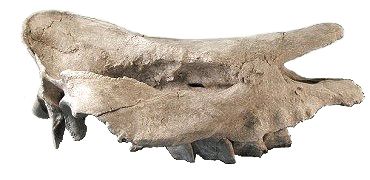
Teleoceras was a short-legged, barrel-bodied rhino that may have spent considerable time in the water like modern hippos. Complete skulls of any fossil animal are unusual, but finding articulated skeletons is quite rare. These specimens, from Ashfall Fossil Beds in Antelope County, are the most complete and well-preserved Teleoceras skeletons in the world!
Pliohippus, Stout One-toed Horse
Family: Equidae
Geologic age: Late Miocene (Clarendonian), 11.83 million years old
Year fossil collected: 1979
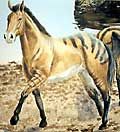
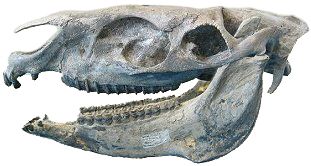
For most of its existence, Pliohippus had three functional toes on each foot. By twelve million years ago, however, the side toes became more and more reduced. At the Ashfall Fossil Beds near Orchard, Nebraska, some members of this group still had three toes, but many had lost the side toes all together. Reduction of side toes is an adaption to open spaces and solid ground, and allows an animal to move quickly to avoid predators.
Balearica exigua, Crowned crane
Family: Gruidae
Geologic age: Late Miocene (Clarendonian), 11.83 million years old
Year fossil collected: 1978

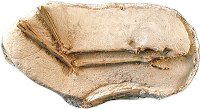
Like rhinos and camels, crowned cranes might seem out of place in Nebraska. Though there is no evidence that the crowned crane originated in Nebraska, it was certainly present in the state 12 million years ago. Today, crowned cranes are limited in range to Africa, and are the only cranes that do not migrate.
Geological Ages of Rock Formations
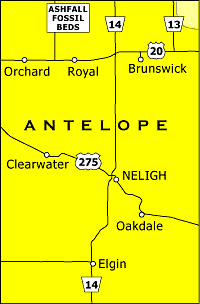
| Q | Pleistocene ("Ice Age") Sands, gravels, silts overlay much of the county (not shown) Pleistocene sands, gravels and silts overlay much of Nebraska and often conceal the bedrock beneath. These "Ice Age" deposits often produce the remains of mammoths, bison, horses, musk oxen, elk and other familiar mammals. Small fossils, especially, are important indicators of the climate at the time of deposition. |
| Tpo | Tertiary, Miocene/Pliocene, Ogallala Group, 2-14 million years old Ogallala Group rocks include predominantly clastic sands and sandstones composed of a mixture of Rocky Mountain debris and locally derived and re-worked sediments. Ash beds are not unusual in the Ogallala and help to precisely date the sediments. In western and southwestern Nebraska, the Ogallala beds are responsible for resistant bluffs that cap the valley sides of modern streams. |
| Kp | Cretaceous, Pierre Formation, 66-78 million years old The Upper Cretaceous Pierre Formation was deposited in the deeper portions of the Cretaceous mid-continental seaway. It consists primarily of fine black shales. Roads and structures built on Pierre Shale hillsides often slump as the shale becomes wet. The unit produces a variety of marine vertebrate fossils including fish, mosasaurs and plesiosaurs. |





